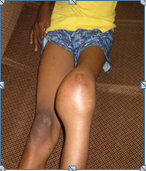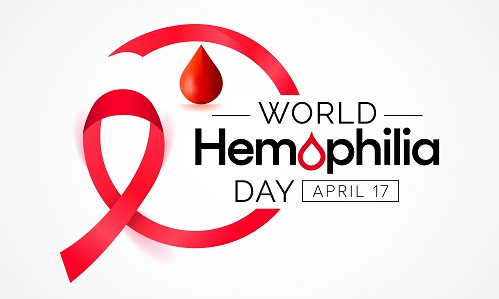She could not believe this was happening all over again, she knew she could not survive it this time. She had experienced too much loss already and the thought of losing her only son sent shivers down her spine.

This mother had lost two children already, the first one at birth and the second on the 8th day of life from prolonged post-circumcision bleeding. The third son called Kofi has Hemophilia just like the first two and is lying limbless on the emergency table at the pediatric unit. Kofi was battling for his life after a minor fall leading to a massive head bleed. This has become the narrative of people living with Hemophilia in this era: a disease that literally means “loves to bleed.”
WHAT IS HEMOPHILIA
Hemophilia is a bleeding disorder where an individual’s blood does not clot properly due to insufficient blood-clotting proteins (clotting factor) that help stop bleeding. Affected individuals can bleed spontaneously or bleed excessively following an injury or surgery.
This bleeding disorder is mostly inherited. There are two main types of hemophilia: hemophilia A and hemophilia B. Affected persons have low levels of clotting factors VIII (8) and X (9) respectively. The disease is caused by a mutation in a gene that sits on the X chromosome. Males have one X and one Y chromosome (XY), and females have two X chromosomes (XX). Hence males are affected when they inherit a chromosome from their mothers. The disease consequently affects more males than females, as males have only one X chromosome. A female carrying the defect on one of her X chromosomes may not be affected by it. A carrier mother has a 50% chance of passing the faulty X-chromosome to her daughter, while an affected father will always pass on the affected gene to his daughters. A son cannot inherit the defective gene from his father. Hemophilia affects all races and ethnicities with an occurrence of 1 in every 10,000 births.
SYMPTOMS OF THE DISORDER
Patients with this disease commonly present with bleeds in joints and muscles causing swelling, pain, and tightness. They have easy bruising, nose bleeds, gum bleeds, and bleeds that are difficult to control after losing a tooth. They may even present with blood in their stools and urine, post-vaccination bleeds, vaccination site swelling, and life-threatening bleeding in the head, chest, or abdomen.
The earliest symptom that could point to this diagnosis usually occurs after birth; bleeding from the cord, scalp swelling, and most importantly, prolonged bleeding after circumcision. Post-circumcision bleed has been the bane of most marriages as couples lose their sons from prolonged bleeding after the procedure. Without treatment, patients end up with disabling joint arthropathy, which directly affects their quality of life.
BLEEDING IN WOMEN
Females can also have hemophilia, but it is rare. When a female has hemophilia, both X chromosomes are affected, or one is affected and the other is missing or non-functioning. In these females, bleeding symptoms can be like males with hemophilia. When a female has one affected X chromosome, she is a “carrier” of hemophilia. Being a female carrier of hemophilia is not the same as having hemophilia, although female carriers may experience symptoms of hemophilia. A female carrier can also pass the affected X chromosome on to her children. Females with hemophilia bleed for more than seven days during menstruation. They bleed heavily with clots which limits daily activities such as work, exercise, etc. They are usually diagnosed with low iron and bleed excessively after birth or other medical procedures.
AVAILABLE TREATMENT IN GHANA
The current standard of care for hemophilia is to control or prevent bleeding episodes through factor replacement therapy, given by regular intravenous (IV) infusions. Currently, in Ghana, only two centers i.e., Komfo Anokye Teaching Hospital and Korle-Bu teaching hospital offer comprehensive care to patients with bleeding disorders to improve their quality of life. There are other satellite HTCs such as Sunyani Regional Hospital, Effia Nkwanta Regional Hospital (Takoradi), Sefwi Wiawso Municipal Hospital, Tamale Teaching Hospital, Cape Coast Teaching Hospital, etc. These centers were established with the support of the Ghana Hemophilia Society (G.He. S), a non-profit organization founded by Mr. Martin Boakye in 2009, G.He.S educates, trains health workers, and advocates for people living with hemophilia. Currently, the society has, in collaboration with the treatment centers, about 500 Hemophiliac patients in their database who are being supported in treatment and care. The society through its enviable work has gained recognition and membership from the World Federation of Hemophilia, Canada.
The Humanitarian aid program by the World Federation of Hemophilia (WFH) also provides factor replacement concentrate to patients living with hemophilia in Ghana at no cost to them. Patients are given these factors to prevent bleeding weekly or on-demand when they present with bleeding episodes.
POTENTIAL FOR CURE: GENE THERAPY
Gene therapy offers the possibility of a permanent cure for any of the more than 10,000 human diseases caused by a defect in a single gene. Among these diseases, hemophilia represents an ideal target, and studies in both animals and humans have provided evidence that a permanent cure for hemophilia is within reach. Gene therapy which has a curative intent is currently under development and trials in the Western world.
CHALLENGES OF CARE IN GHANA
The challenges with respect to the management of patients with hemophilia, and Von Willebrand disease among others in Ghana ranges from lack of public awareness, through deficiencies in the skills of health professional to unavailability and inaccessible diagnostic investigations. The majority of the patients cannot afford the laboratory investigations required in the diagnosis and management of this disease. Like most chronic diseases, parents of children with hemophilia are left to shoulder the burden of all the required laboratory investigations by themselves.
WORLD HEMOPHILIA DAY
World Hemophilia Day (WHD) is an international observance day held on the 17th of April by the World Federation of Hemophilia (WFH). This year’s theme is “Access for All: Prevention of Bleeds as The Global Standard of Care. Building on last year’s World Hemophilia Day theme, the call to action for the community in 2023 is to come together and advocate with local policymakers and governments for improved access to treatment and care with an emphasis on better control and prevention of bleeds for all people with bleeding disorders (PWBDs). This means the implementation of home-based treatment as well as a prophylactic treatment to help those individuals have a better quality of life.
That mother’s prayers were answered, and she went home with her son Kofi, who is currently living his best life on the novel therapy, emicizumab. Kofi may have escaped death, but the journey was a daunting one and one must go through that. As said by the current WFH president, Cesar Garrido; “There is nothing more moving for someone in our community to hear about than a child with a bleeding disorder playing with friends, going to school, and simply enjoying a better quality of life because they have access to proper treatment. Controlling and preventing bleeds really is critical to a better quality of life.















